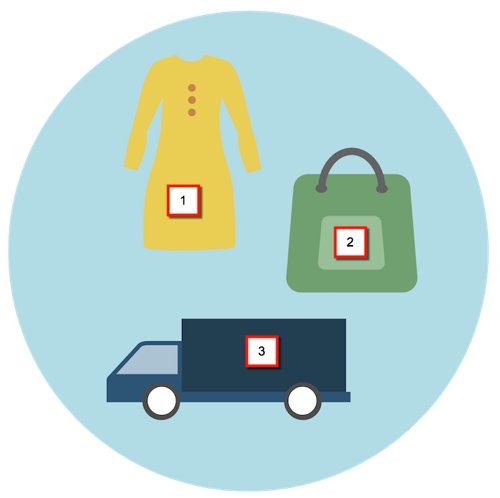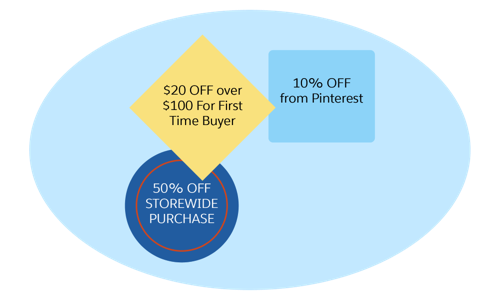Explore Campaigns and Experience Types
Learning Objectives
After completing this unit, you’ll be able to:
- List three ways to guarantee a campaign’s success.
- List the four experiences you can configure in a campaign.
- Describe the three promotion classes.
- Explain how qualifiers work relative to promotions and campaigns.
Introduction
Brandon Wilson is a merchandiser for Cloud Kicks, a company that specializes in high-end sneakers. He wants to present his company’s products in a compelling way on the Cloud Kicks ecommerce site, improve their conversion rate, and increase the average order size.

It’s a significant job!
The Cloud Kicks storefront runs on Salesforce B2C Commerce, part of Salesforce Commerce Cloud. B2C Commerce lets Brandon create full-blown campaigns that provide awesome experiences targeted at specific shoppers for a scheduled period.
To help guarantee success, when Brandon creates a campaign, he determines:
- Audience
- Marketing sources (affiliates, email)
- Site promotion messaging locations (homepage, category pages, checkout)
- Experiences
- Qualifiers
- Products or categories in each promotion
- Schedules
He gets a lot of help, including content from the marketing team. It’s his job to design the campaign and implement it on the storefront. Let’s go along with him as he learns how campaigns and experiences work in B2C Commerce. In later units, we watch as he creates qualifiers and promotions and then uses them to create a campaign.
What’s a B2C Commerce Campaign?
A B2C Commerce campaign contains scheduled experiences that are targeted at a specific set of shoppers. Experiences can be promotions, content slots, sorting rules, and keyword search sorting rules (you’ll learn more about each of these shortly). Shoppers must qualify for an experience. Experiences must run within the campaign’s overall schedule.
Brandon envisions a spring sale campaign followed by a spring clearance sale campaign to push unsold inventory, and then a summer sale campaign, and so on. In retail, spring campaigns typically begin in January or February, and end in March or April. He wants to use a sports-related theme for each season, starting with spring. Here’s what he has in mind.
-
Spring: New spring running shoes, new spring athletic shorts and t-shirts, and baseball shoes
-
Spring Sales: Marked-down inventory
-
Summer: Hot weather walking gear, shorts and tank tops with a pineapple motif, lightweight hoodies, and tennis and rugby shoes
He wants to target shoppers in his company’s Loyalty Program and lapsed buyers. These are shoppers who haven't purchased in a while.
He can schedule his campaign any way he likes. However, there are a few ground rules. A campaign is defined in the context of a site and not shared among sites. A disabled campaign is inactive and not available to shoppers.
Experience Types
Campaigns can contain multiple experiences. When Brandon ties multiple promotion experiences to one campaign, he gets a single view of all the experiences running at any given time.

While the focus in this module is on promotion experiences, Brandon plans to add content slot and sorting rule experiences later. It’s important, however, that he understands how those experiences fit within his overall campaign.
Here are some of the experiences he’s considering.
Experience |
Description |
|---|---|
Content slot |
A new homepage banner to advertise the sale |
Sorting rules |
Sorting products by clearance items first |
Promotion |
Free shipping for orders over US$100 |
Promotion |
20% off Brand-X running shoes |
Promotion |
15% off orders over $50 |
Brandon already uses content slots and sorting rules on his storefront. You don’t have to configure content slots and sorting rules inside a campaign. But he wants to use them in a more focused way as part of his overall theme.
Content Slots
A content slot is a preconfigured location on the storefront where you can showcase products, categories, content assets, static HTML, or product recommendations. A content asset can be things like text, images, a product carousel, or a marketing graphic. This is where he makes his products shine.
Brandon wants to show exciting new content about the spring sports apparel on the homepage banner content slot and on category landing page banner content slots.
Sorting Rules and Keyword Search Sorting Rules
Sorting rules let you control the order in which products display on the storefront after a search or when viewing a category listing page.
You can bring certain products to the shopper’s attention by having them appear at the top, for example. You can configure a sorting rule or a keyword search sorting rule. The sorting rule experience requires a category, while the keyword search experience does not use categories. An experience can only have one keyword search sorting rule.
You can sort the search results with a single attribute or a weighted blend of multiple attributes.
Here are some other examples of what Brandon would like to do.
-
Dynamic sorting rule: Best sellers sorting rule that uses revenue, units ordered, and conversion rate. Use this rule type to make sure that the best selling items are at the top of the search results list.
-
Category position: A specific sort order for a category. He can place Brand-X running shoes at the top of the search results list.
-
Search placement: Products with the highest relevance within a category show at the top of the list.
-
Search rank: Brandon can rank certain products from high to low, so the higher ranked products are at the top of the search results list.
Brandon already uses Einstein Predictive Sort as a dynamic attribute to deliver tailored and relevant search results to shoppers via predictive intelligence.
Promotions
A B2C Commerce promotion is a set of rules that define how and when a shopper gets a discount, and the details of that discount. Here are the three promotion types (or classes): product promotion (1), order promotion (2), and shipping promotion (3).

Brandon wants to offer these promotions.
-
Product: 20% off Brand-X SuperSpeed running shoes
-
Product: Buy one, get one half-off Brand-Y Xcel athletic shorts and t-shirts
-
Product: Free baseball with a pair of baseball shoes
-
Order: 15% off orders over $50
-
Shipping: Free shipping on orders over $100
What's a Qualifier?
Brandon must consider how shoppers qualify for a promotion. Qualifiers trigger a promotion and can be coupons, customer groups, or source codes.
Shoppers can get a coupon code in an email, for example, or they can be part of a customer group based on their demographics or membership, or they can receive a discount because they navigated from an affiliate group such as Google. A source code embedded in a cookie triggers the discount.

You can set multiple qualifiers for a promotion. For example, Brandon wants to offer 20% off Brand-X SuperSpeed running shoes. To qualify, the shopper must be a Loyalty Program member and enter a coupon code that they received in an email.
That’s super targeted!
Build the Playbook
Brandon’s campaign is more than a configuration. It’s a complete program that he designs and implements. He must consider graphics, timelines, products, categories, marketing sources, and storefront page locations. And where exactly does he place his campaign assets?
Brandon creates a playbook. Here’s his campaign so far.
Description |
Schedule |
|
|---|---|---|
Campaign schedule (start and end dates and times) |
|
Jan 15 to Mar 15 |
Required assets |
|
Not applicable |
Promotions |
|
|
Products and categories |
Products
Categories or subcategories
|
Not applicable |
Audience |
|
|
Marketing sources |
|
|
Messaging location |
|
Not applicable |
He’s already brimming with ideas for the next campaign, but first, he needs to configure this one.
What's the Process?
Brandon starts by creating the campaign. But then he has to stop and create the qualifiers, and then stop again to create the promotions.
Because he’s already planned a detailed approach, here’s a more efficient process.
- Create the qualifiers.
- Create the experiences.
- Create the campaign.

Next Steps
In this unit, Brandon Wilson learned about B2C Commerce campaigns and experiences. He created a campaign plan, which focuses on promotions and qualifiers. In the next unit, he creates the qualifiers.
Resources
- Trailhead: Salesforce B2C Commerce for Merchandisers
- Help: Working with Slot Configurations
- Help: Text Relevance
- Trailhead: Smarter Search with Commerce Cloud Einstein